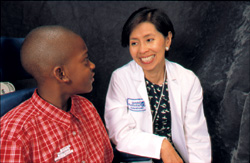National Plan for Eye and Vision Research
Eye disease, a major public health problem in the United States, causes significant suffering, disability, loss of productivity, and diminished quality of life for millions of people. The NEI is addressing this public health problem through its National Eye Health Education Program (NEHEP). In 1988 the U.S. Congress appropriated funds for the NEI to "increase its commitment to the prevention of blindness through public and professional education programs and the encouragement of regular eye examinations." This was the first distinct congressional appropriation designated for eye health promotion and education since the NEI was established in 1968. The three NEHEP program areas are diabetic eye disease, glaucoma, and low vision. The NEHEP is supported by a two-tier advisory structure: the NEHEP Planning Committee and the NEHEP Partnership. The responsibilities of the Planning Committee include recommending program priorities, advising on activities, and facilitating cooperation among the NEHEP Partnership. The Partnership represents over 60 national organizations in the public and private sectors. Partnership members bring vast knowledge of at-risk populations, networks spanning the country, and experience in countless health education efforts. Under the auspices of the NEHEP, the NEI serves as the lead agency for the Healthy People 2010 (HP2010) vision objectives. HP2010, a program of the U.S. Department of Health and Human Services, is the Nation's framework for improving the health of all Americans. The purpose of the NEHEP is to implement large-scale information, education, and applied research programs. It also seeks to ensure that the results of eye and vision research are used for the benefit of all people. The goals of the NEHEP are to:
The NEI continues to develop educational materials guided by the NEHEP goals and objectives that target both patients and providers. The NEI continues to network with community organizations, Federal agencies, allied health care organizations, health care professional groups, and organizations that assist older adults. The NEI maintains that the community (patients/consumers) and those who support the community (providers, social service advocates, and Federal agencies) are key in educating the public. The NEI uses a multidisciplinary approach to reach both primary and secondary audiences. In an effort to make sure that the general public is reached, the NEI has incorporated the use of conferences, teleconferences, standard and online focus groups, print materials (brochures and pamphlets), TV/radio/print public service announcements, websites, audiovisual materials, interactive multimedia programs, traveling exhibits, and posters. The NEI strives to provide culturally specific and appropriate messages for all of the NEHEP content areas and materials. The glaucoma materials are being translated into Spanish. The primary low vision booklet has already been translated into Spanish. The NEI is reviewing the diabetes education materials to translate, update, and perform necessary rewrites to reflect the current state of scientific knowledge. Once modified, all diabetes education materials also will be available in both English and Spanish. The NEI also seeks the advice of the Hispanic/Latino community through focus groups and feedback mechanisms to ensure that the educational tools and materials developed are appropriate for the intended audience. The NEI has begun developing outreach and communication strategies for the American Indian and Alaska Native population. The NEHEP conducted an environmental scan of the vision-related programs and services provided to American Indians and Alaska Natives and identified gaps in eye health information, program services, and materials targeted to these groups.
The NEI maintains an up-to-date website that posts best practices and lessons learned. The NEI encourages NEHEP Partnership members to submit pertinent information or links to websites to assist other NEHEP Partnership members in raising awareness about eye health prevention, education, and treatment. The NEI supports the further development of its website to encompass useful patient-focused information, cutting-edge clinical practices, and lessons-learned approaches to all eye diseases. The NEI has established a Community Awards Program that provides seed money to local communities in establishing eye health initiatives. It is the NEI's desire to increase the representation of racial and ethnic populations and organizations in the NEHEP Partnership. Having a diverse racial and ethnic representation and diversity of thought and perspective is key to the success of the NEHEP Partnership effort. The NEI encourages NEHEP Partners to share the NEHEP mission, vision, and purpose with their respective peers to promote the inclusion of more racial and ethnic groups. Where necessary, the NEI will continue to identify and invite prospective NEHEP Partners as the program continues to expand. The NEI is working on a project to educate eye health care professionals about the issues of vision rehabilitation. The NEI is developing a pilot program to enhance referrals of individuals with low vision to vision rehabilitation services. The primary purpose of the program is to increase patient referrals from eye care professionals to qualified vision rehabilitation services. This program will enable the NEI to develop, test, and evaluate measurable strategies; identify opportunities and barriers; and provide a cadre of health care and eye care professionals and their patients with access to useful sources of information and services. The program also will assist eye care and vision rehabilitation professionals in reaching and providing services to those in need. Once the pilot program has been completed, the NEI will assess its success and utility to eye care professionals and their patients and decide whether to continue the effort. The NEI welcomes any thoughts, suggestions, and/or participation from the NEHEP Partners. One of the NEI's primary purposes for initiating the NEHEP Partnership was to encourage and enhance collaboration with other Federal agencies. This increased communication with other Federal agencies helps avoid duplication and expands the reach of eye health information. The HP2010 Vision Working Group continues discussions centered around strategies to raise awareness about national HP2010 efforts and how local communities and agencies can become involved. The NEI has provided an HP2010 vision website link to all Partnership members through the NEI website. The NEI suggested to all NEHEP Partners that they join in a Memorandum of Understanding with the NEI to work on HP2010 efforts together. The NEI encourages this type of collaborative effort with all of its NEHEP Partners. This collaboration will provide a forum for the development of a common HP2010 theme and message for the vision community. The NEI is developing HP2010 materials for dissemination to the general public, eye health care professionals, and policymakers. These materials include the Healthy Vision 2010 Community Action Guide, Healthy Vision 2010 Toolkit, and the Healthy Vision 2010 Companion Document. The NEHEP Partnership met in April 2002 to develop recommendations for the next 5 years. Those recommendations are:
In addition, two new program areas will be reviewed for consideration based on a careful analysis of the scientific research:
|

